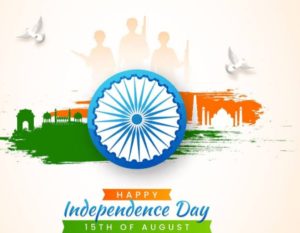Independence Day in India is celebrated on August 15th each year. It commemorates India’s independence from British colonial rule in 1947. The day is marked by flag hoisting ceremonies, patriotic songs, parades, and cultural events across the country. The Prime Minister of India typically addresses the nation from the Red Fort in Delhi. It’s a national holiday and a time for people to remember and celebrate India’s freedom struggle and the sacrifices made by its leaders.
Table of Contents

History of India’s Independence Day
India’s Independence Day, celebrated annually on August 15th, marks the end of British colonial rule in 1947. The struggle for independence was a long and arduous process that spanned decades. Here’s a detailed overview:
Early Movements and Leaders (1857-1919): The Indian Rebellion of 1857 against British rule marked a significant early resistance. However, it was suppressed, and British control was reinforced. Leaders like Mahatma Gandhi emerged, advocating nonviolent civil disobedience as a means to achieve independence.
Non-Cooperation Movement (1920-1922): Gandhi launched the Non-Cooperation Movement, encouraging Indians to boycott British institutions and products. This movement gained widespread support and drew international attention.
Civil Disobedience Movement (1930-1934): The Salt March of 1930, where Gandhi walked 240 miles to the Arabian Sea to protest the British monopoly on salt production, became a symbol of defiance. The movement aimed at breaking unjust laws and practices.
World War II and Quit India Movement (1942):During WWII, Britain’s involvement weakened its hold on India. The Quit India Movement of 1942 demanded an immediate end to British rule. The movement faced severe repression, but it significantly contributed to the eventual independence.
Mountbatten Plan and Partition (1947): The end of WWII led to Britain’s weakened economic and political position, prompting them to expedite India’s independence. Lord Mountbatten proposed a plan to partition India into two independent states, India and Pakistan, based on religious lines.
Independence and Constituent Assembly (1947-1950): On August 15, 1947, India gained independence. Jawaharlal Nehru became the country’s first Prime Minister. The Constituent Assembly worked on drafting India’s constitution, which came into effect on January 26, 1950.
Challenges and Achievements: The immediate aftermath of independence saw challenges related to partition, communal violence, and refugee crises. India adopted a democratic form of government, with universal suffrage and fundamental rights for its citizens.
Nehruvian Era and Foreign Policy: Under Nehru’s leadership, India followed a policy of non-alignment, choosing not to align with either the Western or Eastern bloc during the Cold War.
Economic Reforms and Modernization: India faced economic challenges post-independence. In 1991, significant economic reforms were initiated to liberalize the economy and encourage foreign investment.
Achievements and Progress: Since independence, India has made substantial progress in various sectors, including technology, space exploration, agriculture, and education. However, it also grapples with issues like poverty, corruption, and inequality.
India’s Independence Day is celebrated with flag hoisting, parades, cultural events, and patriotic fervor across the country. It’s a time to reflect on the struggles and sacrifices made during the freedom struggle and to celebrate the nation’s progress and diversity.
Why To Celebrate Independence Day Of India?
Independence Day in India is celebrated on August 15th each year to commemorate the country’s freedom from British colonial rule in 1947. It’s a day to honor the sacrifices made by freedom fighters, reflect on India’s journey to self-governance, and celebrate the principles of democracy, unity, and diversity that the nation stands for. It’s a time for patriotic fervor, cultural performances, and raising awareness about the importance of maintaining and upholding the nation’s sovereignty.
How To Celebrate India’s Independence Day?
Here are a few brief ways to celebrate India’s Independence Day:
1. Flag Hoisting: Raise the Indian flag in your community or home.
2. Cultural Events: Organize or attend cultural performances showcasing India’s diversity.
3. Patriotic Songs: Sing national anthems and patriotic songs.
4. Parades: Participate in or watch local parades featuring patriotic themes.
5. Speeches: Deliver or listen to speeches about India’s history and freedom struggle.
6. Decorations: Decorate with the tricolor (saffron, white, green) and national symbols.
7. Community Service: Engage in activities that benefit your community or the nation.
8. Movie Screenings: Watch films depicting India’s journey to independence.
9. Food Festivals: Enjoy traditional Indian dishes from various regions.
10. Educational Workshops: Learn about the history and significance of Independence Day.
Significance
Independence Day in India, celebrated on August 15th, commemorates the nation’s freedom from British colonial rule in 1947. It holds great significance as it marks the end of decades of struggle, sacrifice, and nonviolent resistance led by leaders like Mahatma Gandhi. The day symbolizes the birth of a sovereign nation and its people’s right to self-determination. It’s a time for patriotism, reflection on national progress, and unity. The Prime Minister addresses the nation, the flag is hoisted, and cultural programs are held across the country.
Conclusion
In conclusion, Independence Day in India stands as a poignant reminder of the nation’s arduous journey towards freedom and self-determination. On this day, the country pays homage to its valiant leaders and the countless sacrifices made by individuals who fought tirelessly for India’s sovereignty. It serves as an annual opportunity for reflection, celebration, and renewal of the nation’s commitment to unity, diversity, and progress. As India continues to evolve on the global stage, Independence Day serves as a time to acknowledge the challenges that lie ahead while celebrating the achievements and aspirations that define the nation’s identity. As the tricolor flag unfurls and the national anthem resonates, Independence Day remains a symbol of hope, resilience, and the collective spirit that defines the Indian people.
Click on the following link
